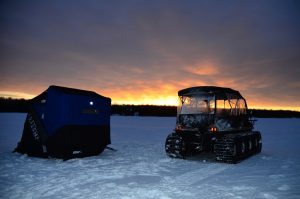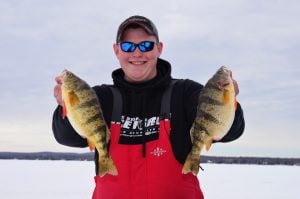The term “jumbo” doesn’t really do justice to the yellow perch anglers who fish Gogebic Lake in Michigan’s Upper Peninsula target. Recently the Fishing 411 crew headed north to sample this unique fishery first hand. We discovered that anglers who target perch on Lake Gogebic don’t have to exaggerate because the perch they catch are impressive by any measure.
“Michigan has lots of lakes that produce noteworthy catches of perch, but I seriously doubt you can find a lake that produces bigger perch than Lake Gogebic,” says Fishing 411 TV host Jake Romanack. “Lots of angler head to Lake Gogebic not to fill their buckets with perch, but to catch their personal best.”
Most anglers don’t think of perch in terms of “trophy status”, but then again most anglers have never seen a true two pound yellow perch! Obviously not everyone who heads to Lake Gogebic is going to come home with a true two pound perch for the wall, but enough of these fish are taken every winter that odds are a trip here will produce a perch worth bragging on for years to come.
PLANNING A TRIP
A good base of operation is a place called Timbers Resort, www.thetimbersresort.com, located in Bergland, at the north end of the lake. Owned by professional angler Tim Long, Tim caters to anglers looking for clean and affordable cabins. “Anglers can literally walk out their cabin door, hop on their snow machine or Argo and head right out onto the ice,” says Long. “A lot of perch and walleye are taken on first ice, but hands down the time of year to visit Gogebic Lake is in March when the “teeter perch” show up on the flats.”

A teeter perch is one who’s belly is so big when you set them on the ice they don’t teeter over! These pre-spawn perch are feeding heavily prior to the ice break up, but the forage these perch are after might surprise anglers.
THE FORAGE BASE
Lake Gogebic has a reputation for producing lots of walleye that run small in size. This is because the forage base of the lake is a little different than other lakes in the region. Walleye do well on a steady diet of mayfly nymphs often called wigglers. This abundant and protein rich forage helps these fish grow quickly, but for walleye once they reach a certain size a diet of aquatic insects doesn’t allow them to continue growing rapidly.
Walleye in Lake Gogebic struggle to gain size after they get about 13 to 15 inches in length. The reason is because the lake doesn’t support a solid population of minnows that are required to help walleye pack on the pounds.
Yellow perch on the other hand do amazingly well on a diet made up primarily of aquatic insects during the winter and early spring. The lack of minnows in Lake Gogebic doesn’t prevent yellow perch from growing rapidly and also growing shoulders. These fish spend much of their time on the mid-lake mud flats that produce the most abundant numbers of mayfly larva.
It’s interesting to note that perch are not the only fish keying on Lake Gogebic’s abundant supply of mayfly larva. White suckers also invade the same flats and these blunt nosed fish are very efficient at rooting the wigglers out of the muddy bottom. Schools of yellow perch slip in and clean up the left overs!
CATCHING IS A LITTLE DIFFERENT
Perch fishing on Lake Gogebic requires a different approach than the typical lake. “You can fish a minnow until you’re blue in the face and not get a quality perch to bite,” says local guide Jon Sibley, www.fishwithguy.com. “I’ve grown up on the lake and the way to catch these perch is to offer them their natural forage. Force feeding these perch minnows just doesn’t work here.”
The natural forage Sibley is referring to are using live wigglers for bait. Just using wigglers however doesn’t guarantee fishing success. “Wigglers are the best bait for our perch fishing, but there is more to the puzzle than just buying wigglers and fishing them.”
The biggest mistake anglers make according to Sibley is they jig to aggressively and too often. “The big perch aren’t interested in aggressive jigging presentations,” explains Sibley. “To get the bigger fish to bite requires a technique locally known as “dead sticking” or simply letting the wiggler rest motionless most of the time.”
Sibley uses rod holders to position his lines and sonar to monitor fish movements. “With my flasher running I know the instant a fish shows up below me,” says Sibley. “When I see a fish on the sonar, I pick up one of my rods and lightly wiggle the rod tip just enough to get the wiggler quivering. Sometimes this triggers a strike, but just as often the strike comes on the nearby dead stick that is sitting motionless.”
Keeping the bait still or using very subtle movements is the key to getting bites on Lake Gogebic. Seeing those bites requires another critical piece of equipment known as a spring bobber.
“Lake Gogebic perch bite so lightly you can’t tight line these fish and feel the bite,” warns Sibley. “It takes a spring bobber to consistently detect bites.”
Light line is also a must for targeting these super tanker perch. One and two pound test monofilament and fluorocarbon lines are necessary to generate the maximum number of bites. It also helps to fish the maximum number of lines allowed in Michigan which means fishing two traditional jigging sticks set up on rod holders and a tip-up as a third line.
PERCH FISHING WITH TIP-UPS
Most anglers don’t think of tip-ups as a viable way to target perch, but when set up properly a tip-up becomes a very productive third line. On our trip to Lake Gogebic we were introduced to a new tip up produced in Wisconsin known as the Bite Me Tip-Up, www.boxtipups.com.
These box style tip-ups feature a hyper sensitive trigger mechanism and reel. When a fish bites a counter balance weight on the trigger mechanism allows the tip-up to function with zero resistance . Once tripped, line plays off the reel smoothly so the fish has no clue that it is swimming away with a hook in it’s mouth!
The box design also keeps snow from blowing into the hole and these tip-ups can also be heated by using a single charcoal briquette to prevent ice from forming in the hole.
The final piece of the puzzle when targeting perch and other light biting fish with the Bite Me Tip-up is using ultra light line and also very small treble hooks at the terminal end. For our perch fishing we were using No. 12 treble hooks and the smallest BB size shot possible to sink our wigglers to depth.
SPREADING OUT IS IMPORTANT
Another benefit of the tip-up rig is it helps anglers spread out their fishing lines so they are targeting more water. The perch of Lake Gogebic are constantly wandering the flats. Adult perch don’t show up in huge schools, but instead travel in smaller pods of other adult fish. When anglers set up right next to one another they are effectively competing with themselves and hurting their ability to find and catch these perch.
The best strategy is for anglers to spread out on the flats and cover the most water possible. Being patient is also important because essentially the angler is waiting for fish to appear on the sonar.
The thing to keep in mind with Lake Gogebic perch is this is not a fishery where anglers can come and fill five gallon buckets. In fact, the perch limit on Lake Gogebic is only 25 fish a day and only five fish over 12 inches are allowed in the bag.
Special harvest restrictions were insisted upon by the local lake association who feared that the “jumbo perch” of Lake Gogebic could be easily over-fished. This unique fishery survives in part because of it’s remote location in the western Upper Peninsula. Just as important however are the special fishing regulations that help insure Lake Gogebic’s “teeter perch” will amaze generations of anglers for years to come.

- Categories:
- Fishing
